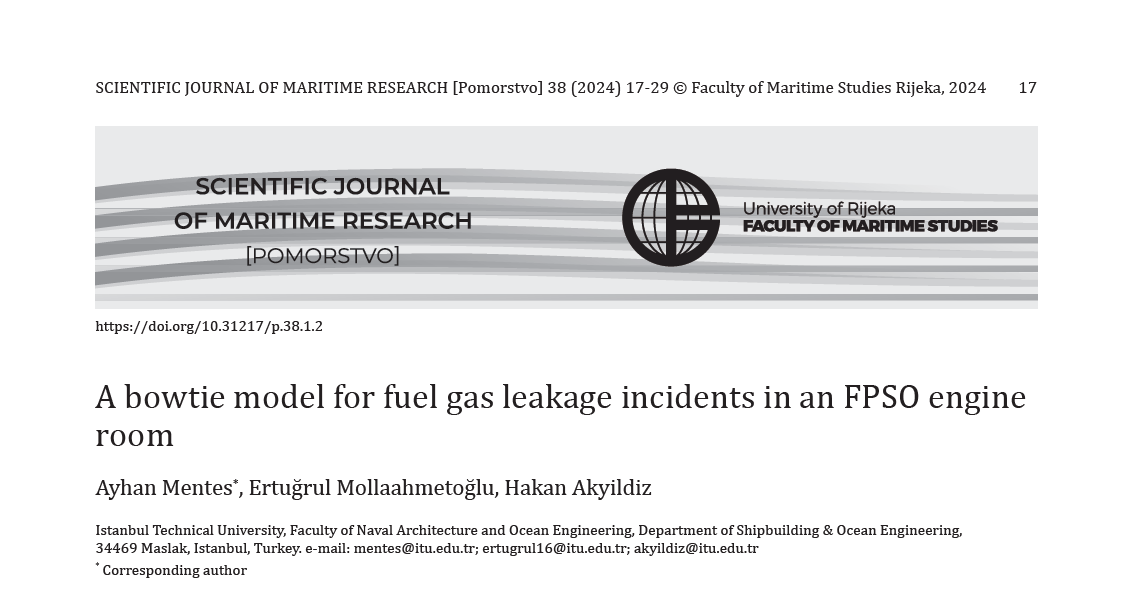A BOWTIE MODEL FOR FUEL GAS LEAKAGE INCIDENTS IN AN FPSO ENGINE ROOM
Keywords:
Condition Based Maintenance, Preventive Maintenance, FPSO Units, Safety Barriers, Bowtie AnalysesAbstract
Safety and operational costs are of paramount importance in offshore facilities. Efforts to find new ways to reduce operational costs and minimize risks have led to the development of techniques in the field of safety. Routine checks and equipment maintenance are conducted based on either calendar periods or equipment uptime, using conditional monitoring, to prevent malfunctions through preventive maintenance (PM). PM is a key strategy for ensuring the integrity and process safety of safety barriers in offshore facilities. However, due to challenges in modeling dependencies, determining maintenance intervals, and updating belief in operational data, ineffective safety barriers can occur and lead to incidents. Excessive maintenance can also increase the risk of operational mistakes among workers. This study examines safety and operational issues associated with fuel gas leak events caused by various risk factors in Floating Production Storage and Offloading (FPSO) engine rooms using the bow-tie model. Within this context, safety barriers are defined, encompassing both preventive controls and mitigating measures that can be employed to minimize potential risk factors. Furthermore, the study underscores the importance of maintenance intervals for a specific set of safety barriers, necessitating periodic testing using Condition-Based Maintenance (CBM) tools for FPSO units.

Downloads
Published
Issue
Section
License
Copyright (c) 2024 Editor

This work is licensed under a Creative Commons Attribution-NonCommercial-NoDerivatives 4.0 International License.
Scientific Journal of Maritime Research understands the need for authors to disseminate and maximize the impact of their research. When submitting an article for publishing in Scientific Journal of Maritime Research, it implies that the Corresponding Author transfers, with the consent of all Coauthors, the copyright ownership in the referenced submission, including all versions in any format now known or hereafter developed, to the Scientific Journal of Maritime Research.
Copyright protects your original work and research material and prevents others from using it without your permission. Others will be required to credit you and your work properly, thus increasing its impact. Should your submission be rejected or withdrawn prior to acceptance for publication by Scientific Journal of Maritime Research, this transfer will be null and void.
Authors, users or readers of an article need clear instructions on how they can use the article. Scientific Journal of Maritime Research uses the Creative Commons Attribution-NonCommercial-NoDerivatives (CC-BY-NC-ND) 4.0 International License, which governs the use, publishing and distribution of articles by authors, publishers and the wider general public.
The authors are allowed to post a digital file of the published article, or the link to the published article (Scientific Journal of Maritime Research web page) may be made publicly available on websites or repositories, such as the Author’s personal website, preprint servers, university networks or primary employer’s institutional websites, third party institutional or subject-based repositories, and conference websites that feature presentations by the Author(s) based on the published article, under the condition that the article is posted in its unaltered Scientific Journal of Maritime Research form, exclusively for non-commercial purposes.




